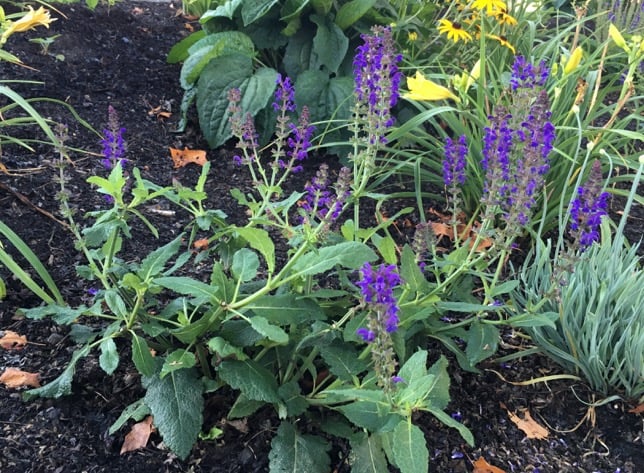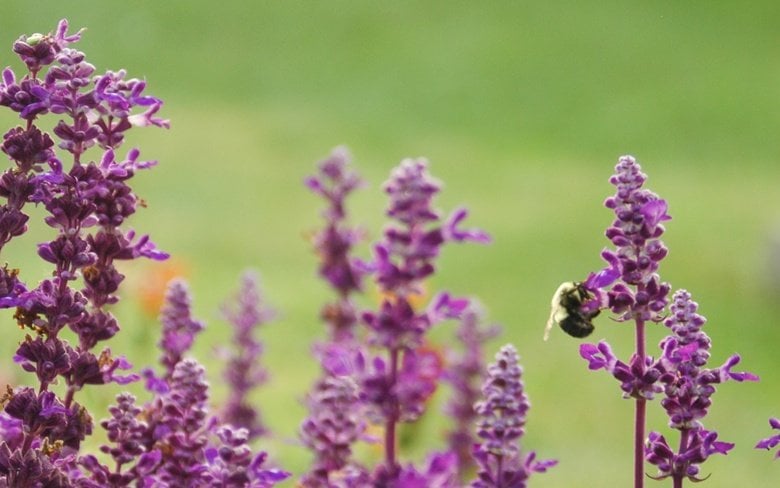…and the answers to many other questions about this popular plant
Salvias are like that old childhood friend you still love to hang out with: easy-going, dependable, and undeterred by life’s ups and downs. Salvias are perhaps the easiest perennial, next to daylilies, that just about anyone can grow with success. There are so many amazing choices of Salvia that it’s hard to get bored by them.
Salvias are beautiful! Simple as that.
Many gardeners are already familiar with Salvia and for good reason. There are over NINE HUNDRED species in the genus Salvia and it’s a mainstay in gardens all over the world. If you’re one of those gardeners who’s already growing Salvia but have some concerns about how to properly care for it, this short, informative video on How to DeadHead Salvia may be of interest to you.

Before and after deadheading Salvia images

Salvia Before Deadheading

Salvia After Deadheading
Just who is this Salvia anyway?
Salvia is part of the mint family (Lamiceae), and with over 900 species worldwide, it can be found on virtually every major continent except Antarctica. In some areas of the world they grow into shrubs that stay green all year long. In others, there are herbaceous types that die back in the colder seasons and woody types, which stay up after losing their leaves in the winter.
Overall, Salvia prefers to grow in hot, dry conditions with well-drained soil. Salvia will not be for you if your garden is too moist, boggy, or shady.
So why write about Salvia?
 Well, for starters, because they’re beautiful, easy, and dependable flower-garden friends. Undeterred by drought, deer, rabbits, woodchucks, beetles, or slugs, Salvia just keeps motoring along, all season long. They need very little attention and pay you back with interest when you pay them the right kind of attention. How many things in life are that dependable?
Well, for starters, because they’re beautiful, easy, and dependable flower-garden friends. Undeterred by drought, deer, rabbits, woodchucks, beetles, or slugs, Salvia just keeps motoring along, all season long. They need very little attention and pay you back with interest when you pay them the right kind of attention. How many things in life are that dependable?
Planting Salvia is also a great way to help the environment. They attract all the critical pollinators, including bees, butterflies, and hummingbirds, to name just a few. So in addition to helping the rest of our gardens flourish, they attract the birds and insects that help grow our local fruits and vegetables.
Did I mention they’re beautiful?
What is Salvia used for?
Lots! Salvia was first cultivated in the Mediterranean where it was a key ingredient in a wide range of culinary and medicinal uses that go back centuries.
Culinary sage is used in more recipes than we have time or space to list here. Cooks everywhere love it for its sweet and savory flavor that goes well with poultry and pork, pairing perfectly with many other classic herbs such as rosemary and thyme. It’s even been used to cure digestive issues, soothe ulcers, and even to treat snakebites.
Salvia divinorum was originally grown in Mexico and used by the Mazatec people as a “vision-inducer” for their spiritual rituals. The elders deeply respected the plant, praying before the harvest, and only using it for meditation and deep spiritual exploration.
What about Salvia for an ornamental garden?
Available in a wide variety of colors, heights, and spreads, Salvia works well with several other perennials that prefer dry, sunny conditions, such as daylilies (Hemerocallis), geraniums, and roses. My hands-down favorite is Salvia nemerosa ‘May Night’, because it’s so robust and dependable, with deep purple flowers that last an astonishingly long time.
Some of my other favorite Salvias include:
- Salvia nemerosa ‘Snow Hill’ has a compact growth habit with long-lasting, pure white flower drifts, and slender leaves.
- Salvia nemerosa ‘Eveline’ features a more open growth pattern with large ovate leaves and tall pink flower spikes in May and June. This one doesn't rebloom as readily but sometimes will push out a few new pink stalks if you deadhead it right after the first bloom.
- Salvia nemerosa ‘Caradonna’ has flowers that are deeper purple and tightly arranged for a stiffer, upright look in the garden.
- Salvia verticilata ‘Purple Rain’ has a bigger serrated leaf that hugs the ground with dark purple flower spikes that are arranged like little pompoms on the stalk. Stunning, but a little more floppy than the nemerosa types.
Just in case you get bored (if that’s possible) with the perennial Salvia that grow in the northern climates, take a look into all the annual Salvias that grow as perennials closer to the equator. They are to-die-for gorgeous, even if you can only grow them in the summertime.
These four are my favorites:
- Pineapple Sage
- Blue Angel Sage
- Black & Blue Salvia
- Lady in Red Salvia
Start them early, feed them with a soluble fertilizer, and watch as they explode with color in the summer heat.
The secret to bigger, better blooms
Many perennial Salvias will bloom twice if you do nothing, but if you dead-head them (remove the old, spent flowers) you can get three or even four blooms in a season. The first flush of bloom is the most robust, but the flowering will linger on all season if you give it a proper pruning after the first bloom.
By proper pruning, I mean dead-heading with care. Often you see gardeners go after the plant with shears or scissors. That is NOT the proper way to do it at all. If you haven’t already checked out the deadheading video above, now might be a good time.
You want to pay attention to the branching architecture and trace the old flower stalks down to where you see two new leaf sets and buds forming on either side of that main stem. The plant is efficiently organized and predictable, so it’s an easy task to perform and well worth the time to learn. It'll feel slow at first, but you'll get the hang of it and in no time you’ll be able to deadhead Salvia quickly, without even thinking about it. Personally, I love the task – it almost becomes a form of meditation.
Regardless of whether you’re a flower newbie or an accomplished gardener, Salvias are a traditional New England favorite because of their beauty, dependability, and ease-of-care. Plant some in your garden if you haven’t already. The bees, butterflies, and hummingbirds will be glad you did -- and so will you!

TWEETABLE TIP
Salvias are like that old childhood friend you still love to hang out with; easy-going and dependable
VIA @GardenContinuum












Leave a comment